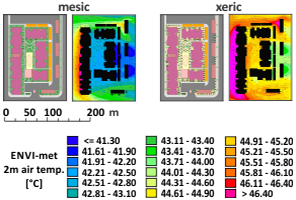Impact of urban form and design on mid-afternoon microclimate in Phoenix Local Climate Zones
Authors
Ariane Middel, Center for Integrated Solutions to Climate Challenges, Arizona State University
Kathrin Häb, Department of Computer Science, University of Kaiserslautern, Germany
Anthony J. Brazel, School of Geographical Sciences and Urban Planning, Arizona State University
Chris A. Martin, Science and Mathematics Faculty, School of Letters and Sciences, Arizona State University
Subhrajit Guhathakurta, Center for Geographic Information Systems, Georgia Institute of Technology
Abstract
 This study investigates the impact of urban form and landscaping type on the mid-afternoon microclimate in semi-arid Phoenix, Arizona. The goal is to find effective urban form and design strategies to ameliorate temperatures during the summer months. We simulated near-ground air temperatures for typical residential neighborhoods in Phoenix using the three-dimensional microclimate model ENVI-met. The model was validated using weather observations from the North Desert Village (NDV) landscape experiment, located on the Arizona State University’s Polytechnic campus. The NDV is an ideal site to determine the model’s input parameters, since it is a controlled environment recreating three prevailing residential landscape types in the Phoenix metropolitan area (mesic, oasis, and xeric). After validation, we designed five neighborhoods with different urban forms that represent a realistic cross-section of typical residential neighborhoods in Phoenix. The scenarios follow the Local Climate Zone (LCZ) classification scheme after Stewart and Oke. We then combined the neighborhoods with three landscape designs and, using ENVI-met, simulated microclimate conditions for these neighborhoods for a typical summer day. Results were analyzed in terms of mid-afternoon air temperature distribution and variation, ventilation, surface temperatures, and shading. Findings show that advection is important for the distribution of withindesign temperatures and that spatial differences in cooling are strongly related to solar radiation and local shading patterns. In mid-afternoon, dense urban forms can create local cool islands. Our approach suggests that the LCZ concept is useful for planning and design purposes.
This study investigates the impact of urban form and landscaping type on the mid-afternoon microclimate in semi-arid Phoenix, Arizona. The goal is to find effective urban form and design strategies to ameliorate temperatures during the summer months. We simulated near-ground air temperatures for typical residential neighborhoods in Phoenix using the three-dimensional microclimate model ENVI-met. The model was validated using weather observations from the North Desert Village (NDV) landscape experiment, located on the Arizona State University’s Polytechnic campus. The NDV is an ideal site to determine the model’s input parameters, since it is a controlled environment recreating three prevailing residential landscape types in the Phoenix metropolitan area (mesic, oasis, and xeric). After validation, we designed five neighborhoods with different urban forms that represent a realistic cross-section of typical residential neighborhoods in Phoenix. The scenarios follow the Local Climate Zone (LCZ) classification scheme after Stewart and Oke. We then combined the neighborhoods with three landscape designs and, using ENVI-met, simulated microclimate conditions for these neighborhoods for a typical summer day. Results were analyzed in terms of mid-afternoon air temperature distribution and variation, ventilation, surface temperatures, and shading. Findings show that advection is important for the distribution of withindesign temperatures and that spatial differences in cooling are strongly related to solar radiation and local shading patterns. In mid-afternoon, dense urban forms can create local cool islands. Our approach suggests that the LCZ concept is useful for planning and design purposes.
Citation
Ariane Middel, Kathrin Häb, Anthony J. Brazel, Chris A. Martin, Subhrajit Guhathakurta, Impact of urban form and design on mid-afternoon microclimate in Phoenix Local Climate Zones, Landscape and Urban Planning, Volume 122, February 2014, Pages 16-28, ISSN 0169-2046, http://dx.doi.org/10.1016/j.landurbplan.2013.11.004.

